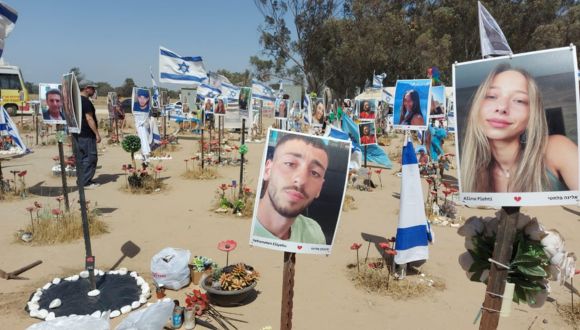
TAU Trip to the Gaza Envelope: Solemn, Yet Essential Experience
Lowy International graduate students witness firsthand the aftermath of October 7th.
In early May, Conflict Resolution & Mediation and Security & Diplomacy MA students embarked on a visit to the Gaza Envelope, including the Nova festival site and the now-infamous “car cemetery,” to witness firsthand the aftermath of October 7th.
For Dalia Gabay, who is studying Conflict Resolution & Mediation, it was a solemn yet essential experience that brought the reality of this conflict to light. Gabay has shared her account of the trip:
However close or involved one has felt to that day’s horrific events and ensuing war by merely being in Israel or through media coverage and seminars, this trip offered a stark reminder of the profound devastation and ongoing heartbreak experienced by Israel’s southern communities and families.
“Our tour guide, Colonel Grisha Yakubovich, who served in the IDF, concluding his military service in 2016 as the head of C.O.G.A.T. (Coordination of Government Activities in the Territories), met us at the Yad Mordechai intersection. He continues to facilitate cooperative enterprises between Israelis and Palestinians and his wealth of knowledge, expertise and personal anecdotes, offered us a realistic insight into the complexities of life and relations across the region for both communities.

Colonel Grisha Yakubovich, the tour guide
Yair, born and raised at Kibbutz Yad Mordechai (aptly named after Mordechai Anielewicz, commander of the Warsaw Ghetto uprising) and now a father of four, showed us around Moshav Netiv HaAsara, just 400 meters away from the Gaza Strip.

Yair talking about Moshav Netiv HaAsara
Inevitably, the moshav was severely hit on October 7, with some 24 residents massacred. The moshav has been deserted but the bullet-ridden walls, trees and disheveled remnants of the attack were enough to communicate the sheer terror of that fateful day; the fear was palpable.
Yair shared tales of unimaginable tragedy and bravery from these close-knit communities, including his own. His kibbutz had prepared for such an event and quickly mobilized as soon as the red alert sirens sounded at around 6:30 AM. “It felt different that day,” he recounted.
While he sat armed in his living room, ready to defend his family locked in the adjoining safe room, the kibbutz security team repelled the terrorist attack at the gate and successfully chased the perpetrators away.
At Netiv HaAsara, he showed us the shelter where a father sacrificed his own life to shield his two sons from the impact of a hand grenade. The boys narrowly escaped being kidnapped and survived the harrowing ordeal.
This is the stuff of legends: October 7th bestowed heroism upon individuals who will forever remain ingrained in Israel’s collective memory.
Yair’s poignant account of life for Israeli residents in the Gazan Envelope, where enduring PTSD from relentless rocket attacks over 16 years is commonplace, will stay with me forever. Their remarkable resilience shines through, yet it’s disheartening to hear how these communities have endured such extreme and volatile conditions for so long, while the government and wider Israeli society appear to observe with almost complacent indifference.
I sincerely hope that the end of this war will bring them much needed solace and pave the way for a return to the peaceful, idyllic life that Yair fondly remembers from his childhood in the region.
Israel’s own “ground zero” where Sderot’s police station once stood, was completely destroyed in the aftermath of Hamas’ invasion and murderous rampage.

Sderot’s police station
Plans are underway for a memorial to honor the lives lost and serve as a lasting reminder of October 7th.

A playground in Sderot
In Sderot, we also visited a children’s playground that’s been adapted to train, and protect youngsters from barrages of rocket attacks. This is the sad reality of Israel’s southern citizens.

A shelter in Sderot
A nearby shelter ended up the final resting place of fleeing Nova festival goers, including Shani Gabay, who happens to share my surname. May her memory forever be a blessing.

The car cemetery
The scene at the “car cemetery,” where burnt and damaged vehicles lay, many with occupants inside, was haunting.
The images captured the terror inflicted upon innocent civilians during this unprecedented attack.
Our journey concluded at Re’im, the Nova festival site, where makeshift memorials were tended to by grieving parents and friends.

Memorials at the Nova festival site
It left many of us in tears as we headed home, somberly reflecting on all that we had witnessed throughout the day.”
“Personally, I needed to go on this trip. The trip reinforced my commitment to my studies in the hope that I’ll be able to contribute in some way towards a peaceful future for all Israelis and Palestinians in our shared land.”
Text and pictures by Dalia Gabay
